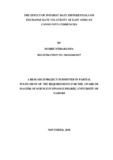| dc.contributor.author | Desire, Ntirabampa | |
| dc.date.accessioned | 2019-01-28T09:32:10Z | |
| dc.date.available | 2019-01-28T09:32:10Z | |
| dc.date.issued | 2018 | |
| dc.identifier.uri | http://hdl.handle.net/11295/105695 | |
| dc.description.abstract | The study sought to test the effect of interest rate differentials on the exchange rate volatility of East African Community currencies. The literature developed was steered by the Purchasing Power Parity theory, Fisher Effect theory and the International Fisher Effect theory. The study used a descriptive research design and the sources of information were Central Bank of Kenya, Bank of Uganda, Bank of Tanzania, Bank of the Republic of Burundi, National Bank of Rwanda and the IMF e-Library. Average monthly exchange rates, interest rate differentials, inflation rate differentials and relative current account balances are the data used for a period starting from January 2013 to December 2017. A panel data regression model was used to model the relationship between the dependent variable (exchange rate) and explanatory variables (interest differential, inflation differential and relative current account balance). Hausman test showed that the fixed-effects model is the suitable model to be used for our study. Therefore, the study found that 98.8% of the variation in the dependent variable is explained by the three independent variables. Interest differential was the main predictable variable with a coefficient’s value of 0.0274 which means that in EAC an increase by 1 point in interest rate differential leads to the depreciation of home currency by 0.0274 points. Relative current account balance contributes also to home currency depreciation with a coefficient’s value of 0.000052. However, the study could not be able to find the expected results for inflation differential as it has a negative coefficient’s value (-0.0075). This contradicts the economic theory on inflation differential and may due to other variables that were not included in the regression but can have a great importance in the explanation of exchange rate movement. The unfortunate coefficient may also due to computations done in this study to find monthly data on the current account balance of Rwanda and Uganda as these countries do not publish monthly data on that variable. That was the major limitation of this study. The study further suggested that more research be carried out to bring forth more knowledge to the pool of literature on relationship between interest rate differential and exchange rate volatility in the region of EAC. | en_US |
| dc.language.iso | en | en_US |
| dc.publisher | university of nairobi | en_US |
| dc.rights | Attribution-NonCommercial-NoDerivs 3.0 United States | * |
| dc.rights | Attribution-NonCommercial-NoDerivs 3.0 United States | * |
| dc.rights.uri | http://creativecommons.org/licenses/by-nc-nd/3.0/us/ | * |
| dc.rights.uri | http://creativecommons.org/licenses/by-nc-nd/3.0/us/ | * |
| dc.subject | Exchange Rate Volatility | en_US |
| dc.title | The Effect of Interest Rate Differentials on Exchange Rate Volatility of East African Community Currencies | en_US |
| dc.type | Thesis | en_US |



